The viewer watches an elderly Chinese woman, gaunt, bed-bound and wrapped in several layers of cloth. She seems too weak to even groan. A person approaches, removes plastic bags and rags that bind part of her body. It takes a few moments to realize what the video is depicting: the dying woman’s leg has rotted to the point that it’s a barely recognizable. She is the first person artists James T Hong (洪子健) and Chen Yin-ju (陳瀅如) met and filmed for their ongoing project about the history and victims of Japanese biological warfare in China during World War II.
“Nobody has done a documentary about [the victims]. No one cares. We picked this up because it was the idea of finding [living] proof,” Hong told the Taipei Times.
Grim history
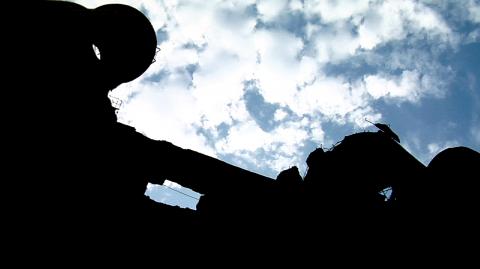
Photo courtesy of James t Hong and Chen Yin-ju
Pingfan, a suburb of Harbin, China is the starting point of the artists’ more than six-year investigation of Unit 731, the notorious headquarters of Imperial Japan’s biological weapons program, the ruins from which still exist. The scientific military unit, led by microbiologist Shiro Ishii, aimed to perfect biological weapons by experimenting on living humans, and resulted in the murder of thousands.
“When you have disease in your body, your body tries to fight it. And germs that aren’t killed by your white blood cells become stronger. [The Japanese scientists] cut people open, extracted their organs, removed those germs, bred more and put them into other people. Each time the germs became stronger. That’s why they were so good at killing people,” Hong says, explaining the lab’s operation.
In the early 1940s, the secret unit carried out a series of field tests, mostly in Zhejiang Province, designed to disperse biological weapons into large populations. Low-flying planes dropped plague-infected fleas, bacteria-contaminated foodstuffs and other vectors carrying pathogens including anthrax, glanders, cholera and typhoid onto towns and villages. Epidemic outbreaks followed; many civilians died within weeks.
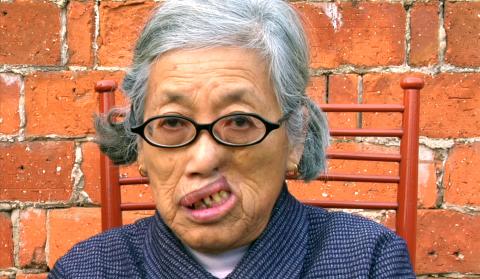
Photo courtesy of James t Hong and Chen Yin-ju
Hong initially made a short video essay titled 731: Two Versions of Hell (2006-2007), which uses the same film footage as seen from the Chinese and Japanese perspectives to illustrate how history is slanted, omitted and constructed for political purposes. As the artist couple dug deeper, they met and interviewed elderly survivors in rural hamlets known as “rotten leg villages” (爛腳村) — so-called because victims of the biological experiments have open wounds on their legs that have never healed, even after 70 years.
Hong and Chen subsequently made three documentary films, all of which are currently on display at the Chi-Wen Gallery. The first part of the exhibition, which runs until July 9, shows Wounds that Never Heal (恆傷, 2009-2010) and Cutaways of Jiang Chun Gen — Forward and Back Again (前進倒退: 切剖姜春根, 2012), a quietly disturbing portrait of an elderly peasant who was infected by glanders in 1942 when he was two years old. Glanders is an infectious disease caused by bacteria mainly found in horses.
Lessons of the Blood (歷史血痕, 2004-2010), to be screened at the gallery between July 9 and July 27, is a feature-length work and a longer version of Wounds that Never Heal.
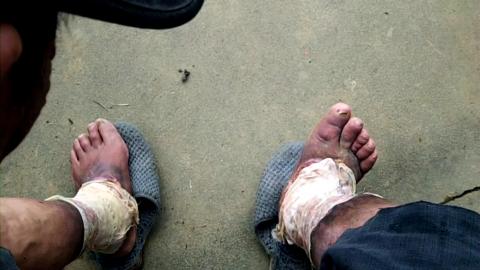
Photos courtesy of James t Hong and Chen Yin-ju
The film examines Japan’s biological warfare and its legacy in China, and covers issues such as the crimes committed by the imperial government during the Sino-Japanese War and World War II, the denial of war crimes by Japanese politicians, the changing historical role of the US relationship with Japan and China, and personal stories about those individuals still suffering from the horrendous results of Japan’s biological warfare.
For Hong, juxtaposing the complex history and the undeniable human pain is a way to shed light on what is left unsaid and hidden by the official history.
“The Chinese communist party has never done investigations … There are groups of Japanese going to China to investigate. Many American documents have been declassified. But it is not human documentary evidence … Victims are the proof,” he says.
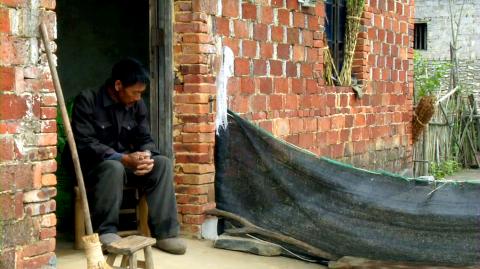
Photo courtesy of James t Hong and Chen Yin-ju
An interest in death
Hong says he’s interested in mass murder. For last year’s Taipei Biennial, Hong co-curated an exhibition titled the Museum of the Monster that is History, which dwells upon the subject of institutionalized violence and state-sanctioned forms of terror.
Nazism is another recurrent theme in his works. The Denazification of MH, for example, is an experimental documentary that explores German philosopher Martin Heidegger’s reluctance to confront his involvement with the Nazis. In Behold the Asian: How One Becomes What One Is, a prophecy of Asian world domination is delivered in the Nietzschean vocabulary that alludes to Nazi ideology. Hong’s politics are not always easy to swallow, and his tactics are often loud and aggressive.
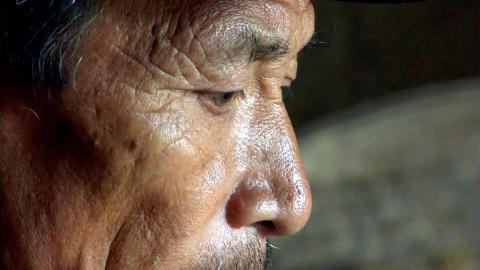
Photo courtesy of James t Hong and Chen Yin-ju
Documentary filmmaking “should be something that has a certain kind of strength, power or teeth. Most [documentaries] I see don’t have teeth,” the artist says.
Born and raised in a Chinese-Taiwanese household in Minnesota, Hong subverts and attacks model minority stereotypes through works that tackle the particularities of the Asian American experience. His confrontational cinema mocks the xenophobia of America and loathes the white man’s obsession with Asian women. In A Portrait of Sino-American Friendship, for example, Hong depicts a fat American businessman talking on his cell phone while a prostrate Chinese woman shines his shoes.
“Typical identity politics films in the US are all about being victims, victims of racism. To me, it’s boring. I want to come from a position of strength, not from a position of weakness,” Hong says. “To me, to assimilate — because I was taught to be just like anyone else — is safe. To be safe, to not stick out.”
Hong gave up his PhD studies in German metaphysics at the University of Illinois at Urbana-Champaign and moved to Los Angeles where he eventually graduated from the University of Southern California’s film school. But the documentary filmmaker says that the formal filmmaking at that time, which plays with the texture, light and material of film, was too tame for his tastes.
“For me, art is argument. You are trying to convey an idea ... I think film should have arguments and should make you remember,” the artist says.
Hong’s oeuvre also provokes people to face and re-examine their own stereotypes, biases and ideology. Cutaways of Jiang Chun Gen — Forward and Back Again, which premiered at this year’s Berlin International Film Festival, elicited shock from audience members who associate Japan with “hi-tech, anime, cute things and sushi.”
“I try to change people’s perceived opinion, to show that lots of stuff we learned in school is either incomplete or wrong,” Hong says.
He adds, somewhat oddly, that the West doesn’t see Japan as a perpetrator of violence.
“They see it as a victim, especially because of the atomic bombs. In Taiwan, China is the enemy; Japan is the friend. That is similar to the US.”
Under wraps
Lessons of the Blood can’t be shown publicly in China because it is critical of the communist party. Hong says there are currently only a few tiny museums started by the victims, and there are only limited investigations done by a few cities in Zhejiang.
In 1997, a group of biological warfare victims, led by Chinese activist Wang Xuan (王選), filed a lawsuit against the Japanese government. While a Japanese court concluded that the imperial government did commit acts of biological warfare in China, the government claimed that the issue of responsibility was resolved because China gave up the right to seek war reparations in the 1972 Joint Communique of the Government of Japan and the Government of the People’s Republic of China.
Victims, meanwhile, have received nothing from the Chinese government. Donations and aid mostly arrives from overseas.
Wang, speaking through Skype at the exhibition’s opening, said there is simply not enough care for the survivors.
“In China, on the media, we talk about how the Japanese military brutally killed the Chinese, and how poor and wretched those victims are. But when it comes to how we should help and care for them, no one talks,” she says.
For years, Wang has led college students to conduct inquiries throughout the region and bring medical care to the sick. It is virtually impossible to form a non-governmental organization for the war victims in China, where only apolitical NGOs are allowed. And the suffering of the victims “is by its very nature political,” Hong says.
Wang believes that in order to have a system of social aid for war victims, the government should carry out official investigations and set up a “database upon which a policy can then be based.” But the question remains whether or not such policy works toward the benefit of the authorities.
“Once the welfare policy starts, it should apply to all those injured and mistreated. But is the Chinese government willing to admit that it has also done damage to its own citizens?” she asks rhetorically.
In collaboration with Chi-Wen Gallery and the Taipei Women’s Rescue Foundation (婦女救援基金會), the exhibition by Hong and Chen is also a fundraising event for the rotten leg victims. All donations will go to victims through Wang and her group.
“It is summer now. The stench of [the wounds] will become unbearable. It is important that they have disinfectants and clean bandage to clean their wounds several times a day,” Wang urges.
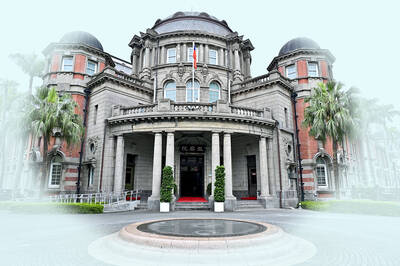
The Taipei Times last week reported that the Control Yuan said it had been “left with no choice” but to ask the Constitutional Court to rule on the constitutionality of the central government budget, which left it without a budget. Lost in the outrage over the cuts to defense and to the Constitutional Court were the cuts to the Control Yuan, whose operating budget was slashed by 96 percent. It is unable even to pay its utility bills, and in the press conference it convened on the issue, said that its department directors were paying out of pocket for gasoline
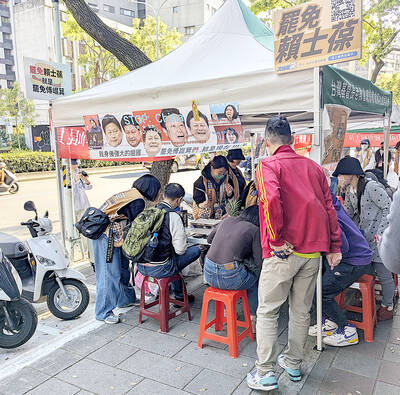
On March 13 President William Lai (賴清德) gave a national security speech noting the 20th year since the passing of China’s Anti-Secession Law (反分裂國家法) in March 2005 that laid the legal groundwork for an invasion of Taiwan. That law, and other subsequent ones, are merely political theater created by the Chinese Communist Party (CCP) to have something to point to so they can claim “we have to do it, it is the law.” The president’s speech was somber and said: “By its actions, China already satisfies the definition of a ‘foreign hostile force’ as provided in the Anti-Infiltration Act, which unlike

Mirror mirror on the wall, what’s the fairest Disney live-action remake of them all? Wait, mirror. Hold on a second. Maybe choosing from the likes of Alice in Wonderland (2010), Mulan (2020) and The Lion King (2019) isn’t such a good idea. Mirror, on second thought, what’s on Netflix? Even the most devoted fans would have to acknowledge that these have not been the most illustrious illustrations of Disney magic. At their best (Pete’s Dragon? Cinderella?) they breathe life into old classics that could use a little updating. At their worst, well, blue Will Smith. Given the rapacious rate of remakes in modern
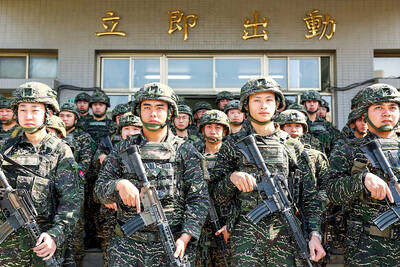
President William Lai’s (賴清德) March 13 national security speech marked a turning point. He signaled that the government was finally getting serious about a whole-of-society approach to defending the nation. The presidential office summarized his speech succinctly: “President Lai introduced 17 major strategies to respond to five major national security and united front threats Taiwan now faces: China’s threat to national sovereignty, its threats from infiltration and espionage activities targeting Taiwan’s military, its threats aimed at obscuring the national identity of the people of Taiwan, its threats from united front infiltration into Taiwanese society through cross-strait exchanges, and its threats from